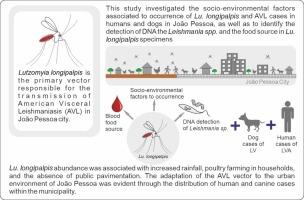Eco-epidemiological factors associated with the incidence of Lutzomyia longipalpis (Diptera: Psychodidae: Phlebotominae), vector of American Visceral Leishmaniasis, in João Pessoa, Paraíba, Brazil
IF 2.2
2区 农林科学
Q2 PARASITOLOGY
引用次数: 0
Abstract
The first recorded human and canine cases of American Visceral Leishmaniasis (AVL) in the municipality of João Pessoa date back to the 1970s, coinciding with the identification of its vector, Lutzomyia longipalpis. This study aimed to investigate the socio-environmental factors associated with the occurrence of Lu. longipalpis and AVL cases in humans and dogs in João Pessoa. Additionally, it sought to detect Leishmania spp. DNA and identify the blood-feeding sources in female sand fly specimens. Light traps were placed of urban residences in João Pessoa per 21 months, and socio-environmental data on human and canine AVL cases were collected with the assistance of the Health Secretariat of the Municipality of João Pessoa. The multiplex PCR was used to detect Leishmania DNA in female Phlebotominae, and the study of the blood-feeding sources was conducted by sequencing cytochrome b gene. Human and canine AVL cases were mapped using Geographic Coordinate Reference System. A total of 1136 sand fly specimens were captured, belonging to five species: Brumptomyia brumpti, Lutzomyia longipalpis, Evandromyia (Aldamyia) evandroi, Psathyromyia (Forattiniella) brasiliensis and Sciopemyia sordellii, with Lu. longipalpis comprising 86.2 % of the specimens. Our study found that higher Lu. longipalpis abundance was associated with increased rainfall, the presence of poultry farming in households, and the absence of public pavimentation. The tests for detection of DNA of Leishmania infantum were positive for Lu. longipalpis, and the sequencing of the cytochrome b detected gene blood meals from Homo sapiens and Gallus gallus in Ev. evandroi. Moreover, the adaptation of the AVL vector to the urban environment of João Pessoa was evident through the distribution of human and canine cases across the municipality. Understanding the socio-environmental factors associated with the spread of AVL in urban areas is crucial for effective surveillance and control strategies.

巴西jo o Pessoa Paraíba与美国内脏利什曼病病媒长肢卢锥虫(双翅目:精神病科:白蛉科)发病率相关的生态流行病学因素
约奥佩索阿市首次记录的美国内脏利什曼病人和犬病例可追溯到20世纪70年代,当时发现了其病媒长鼻Lutzomyia longipalpis。本研究旨在探讨与鲁氏病发生有关的社会环境因素。jo o Pessoa地区人类和狗的长睑肌和AVL病例。此外,还试图检测利什曼原虫的DNA,并确定雌性沙蝇标本的吸血来源。在约奥佩索阿市卫生秘书处的协助下,每21个月在约奥佩索阿市的城市住宅中放置灯光陷阱,并收集了人类和犬类AVL病例的社会环境数据。采用多重PCR法检测雌性白蛉利什曼原虫DNA,并对其血源进行细胞色素b基因测序。利用地理坐标参考系对人、犬AVL病例进行制图。共捕获沙蝇1136只,分属5种:Brumptomyia brumpti、Lutzomyia longipalpis、Evandromyia (Aldamyia) evandroi、Psathyromyia (Forattiniella) brasiliensis和Sciopemyia sordellii。长掌肌占标本的86.2 %。我们的研究发现,较高的Lu。长肢鼠的丰度与降雨增加、家庭中家禽养殖的存在以及缺乏公共人行道有关。婴儿利什曼原虫DNA检测结果均为阳性。细胞色素b的测序检测到了来自智人和野鸭的基因血餐。evandroi。此外,通过整个城市的人类和犬病例分布,AVL媒介对jo o Pessoa城市环境的适应是显而易见的。了解与城市地区AVL传播相关的社会环境因素对于制定有效的监测和控制战略至关重要。
本文章由计算机程序翻译,如有差异,请以英文原文为准。
求助全文
约1分钟内获得全文
求助全文
来源期刊

Veterinary parasitology
农林科学-寄生虫学
CiteScore
5.30
自引率
7.70%
发文量
126
审稿时长
36 days
期刊介绍:
The journal Veterinary Parasitology has an open access mirror journal,Veterinary Parasitology: X, sharing the same aims and scope, editorial team, submission system and rigorous peer review.
This journal is concerned with those aspects of helminthology, protozoology and entomology which are of interest to animal health investigators, veterinary practitioners and others with a special interest in parasitology. Papers of the highest quality dealing with all aspects of disease prevention, pathology, treatment, epidemiology, and control of parasites in all domesticated animals, fall within the scope of the journal. Papers of geographically limited (local) interest which are not of interest to an international audience will not be accepted. Authors who submit papers based on local data will need to indicate why their paper is relevant to a broader readership.
Parasitological studies on laboratory animals fall within the scope of the journal only if they provide a reasonably close model of a disease of domestic animals. Additionally the journal will consider papers relating to wildlife species where they may act as disease reservoirs to domestic animals, or as a zoonotic reservoir. Case studies considered to be unique or of specific interest to the journal, will also be considered on occasions at the Editors'' discretion. Papers dealing exclusively with the taxonomy of parasites do not fall within the scope of the journal.
 求助内容:
求助内容: 应助结果提醒方式:
应助结果提醒方式:


